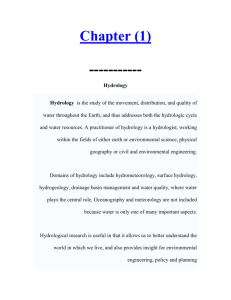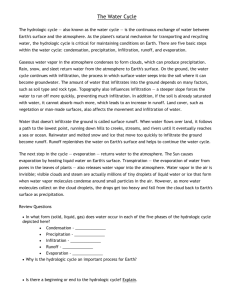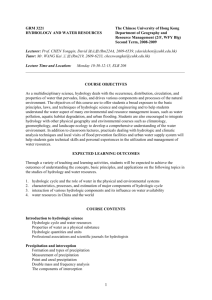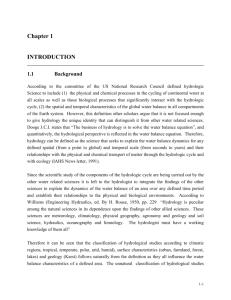DEFINITION AND SCOPE
advertisement
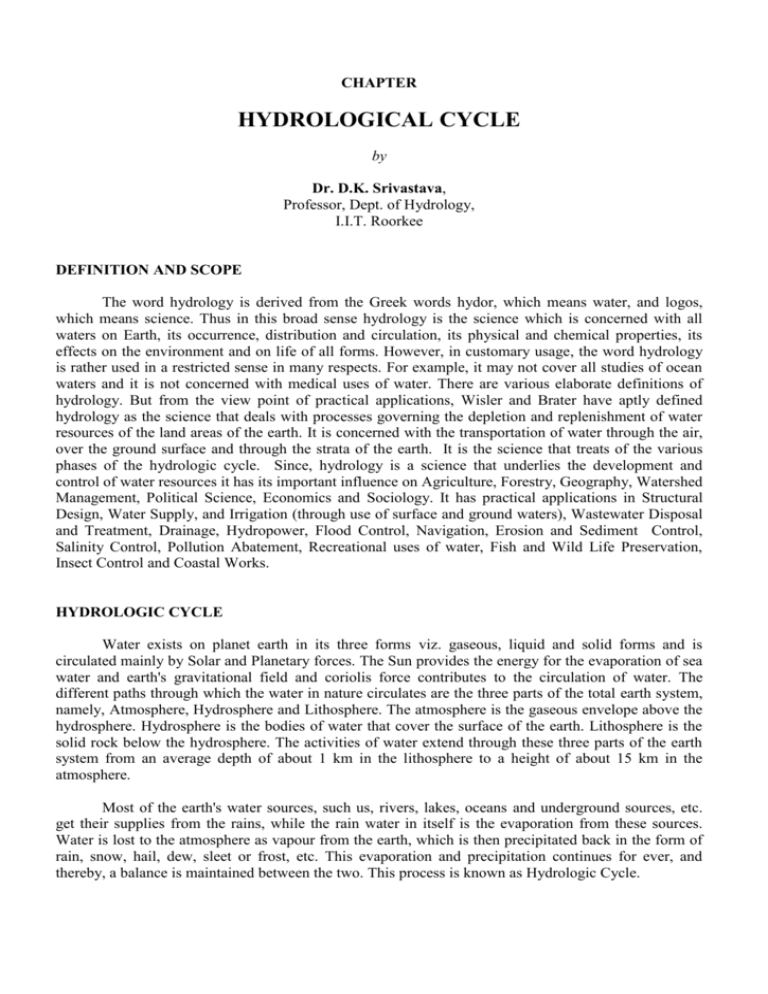
CHAPTER HYDROLOGICAL CYCLE by Dr. D.K. Srivastava, Professor, Dept. of Hydrology, I.I.T. Roorkee DEFINITION AND SCOPE The word hydrology is derived from the Greek words hydor, which means water, and logos, which means science. Thus in this broad sense hydrology is the science which is concerned with all waters on Earth, its occurrence, distribution and circulation, its physical and chemical properties, its effects on the environment and on life of all forms. However, in customary usage, the word hydrology is rather used in a restricted sense in many respects. For example, it may not cover all studies of ocean waters and it is not concerned with medical uses of water. There are various elaborate definitions of hydrology. But from the view point of practical applications, Wisler and Brater have aptly defined hydrology as the science that deals with processes governing the depletion and replenishment of water resources of the land areas of the earth. It is concerned with the transportation of water through the air, over the ground surface and through the strata of the earth. It is the science that treats of the various phases of the hydrologic cycle. Since, hydrology is a science that underlies the development and control of water resources it has its important influence on Agriculture, Forestry, Geography, Watershed Management, Political Science, Economics and Sociology. It has practical applications in Structural Design, Water Supply, and Irrigation (through use of surface and ground waters), Wastewater Disposal and Treatment, Drainage, Hydropower, Flood Control, Navigation, Erosion and Sediment Control, Salinity Control, Pollution Abatement, Recreational uses of water, Fish and Wild Life Preservation, Insect Control and Coastal Works. HYDROLOGIC CYCLE Water exists on planet earth in its three forms viz. gaseous, liquid and solid forms and is circulated mainly by Solar and Planetary forces. The Sun provides the energy for the evaporation of sea water and earth's gravitational field and coriolis force contributes to the circulation of water. The different paths through which the water in nature circulates are the three parts of the total earth system, namely, Atmosphere, Hydrosphere and Lithosphere. The atmosphere is the gaseous envelope above the hydrosphere. Hydrosphere is the bodies of water that cover the surface of the earth. Lithosphere is the solid rock below the hydrosphere. The activities of water extend through these three parts of the earth system from an average depth of about 1 km in the lithosphere to a height of about 15 km in the atmosphere. Most of the earth's water sources, such us, rivers, lakes, oceans and underground sources, etc. get their supplies from the rains, while the rain water in itself is the evaporation from these sources. Water is lost to the atmosphere as vapour from the earth, which is then precipitated back in the form of rain, snow, hail, dew, sleet or frost, etc. This evaporation and precipitation continues for ever, and thereby, a balance is maintained between the two. This process is known as Hydrologic Cycle. The hydrologic cycle can be represented in many different ways in pictorial or diagrammatic forms. It depends on the view point it represents and is simplified in general as it is difficult to represent all aspects of the cycle. Fig. 1 is a descriptive representation of the hydrologic cycle where many of the details are skipped. Though these figures are self-explanatory, a detailed qualitative description of the hydrologic cycle is given below. The hydrologic cycle has no beginning or end as the water in nature is continuously kept in cyclic motion. However, for the purpose of description the cycle may be visualised to commence with the precipitation from the atmosphere. Precipitation may take place in liquid form as rain and also in solid form as hail, snow, dew, frost etc. While precipitation is taking place, a part of it may evaporate and reach back the atmosphere. Some more precipitation is intercepted by the trees and vegetation and the rest of it only would reach the ground. The intercepted precipitation eventually evaporates into the atmosphere. The precipitation reaching the ground surface is called the throughfall. Considerable portion of the throughfall gets infiltrated into the ground and that in excess of infiltration would be detained temporarily on the ground before it becomes overland flow and subsequently surface runoff. The precipitation falling directly over the streams is called the channel precipitation and it readily becomes runoff without any delay. The precipitation falling on the water bodies like ponds and lakes may be disposed of either as surface runoff to streams if the water bodies overflow or as evaporation or as infiltration. The evaporation would also be taking place from stream surfaces. The infiltrated water may be distributed in different ways. First, it supplies moisture to the vegetation and after utilising it for the sustenance of their life, the vegetation sends this moisture back into the atmosphere through the leaves by a process known as transpiration. Secondly, the infiltrated water may percolate deep and become groundwater supply to surface streams known as the groundwater runoff (Fig. 2 and 3), or it may become groundwater supply to oceans. The groundwater runoff is sometimes referred to as the baseflow or the interflow. The total streamflow which is the sum of the surface runoff and the groundwater runoff ultimately joins the oceans wherefrom it again evaporates into the atmosphere thus completing the hydrologic cycle. The entire cycle repeats when the atmospheric moisture precipitates on to the ground after cloud formation. Thus the hydrologic cycle consists of various complicated processes such as precipitation, interception, evaporation and transpiration, infiltration, percolation, storage and runoff. IMPORTANCE OF HYDROLOGY The basic knowledge of this science is a must for every civil engineer, particularly the one who is engaged in the design, planning or construction for irrigation and hydropower structures, bridges and highway culverts, or flood control works, etc. Some of the various questions, which this science will be called upon to answer, while designing the above engineering feats, are: (i) What maximum flows, after different years, are executed at a spillway or a highway culvert, in a city drainage system ? (ii) What minimum reservoir capacity will be sufficient to assure adequate water for irrigation or municipal water supply, during droughts ? (iii) How much quantity of water will become available at a reservoir site, and when will it become available ? In other words, what will be the available possible supplies at the reservoir site ? (iv) What effects on the river water levels will be produced, after the construction of proposed reservoirs, levees, or any other controlling structures ? Generally, specialist hydrologists are rarely employed for answering such questions ; and the civil engineers, responsible for the planning, design and construction of hydraulic structures, are themselves required to answer them; thereby making it an imperative upon them to gain a thorough knowledge of Hydrology. Only then, they will be able to design efficiently and economically functioning hydraulic structures. Fig. 1 Descriptive representation of hydrologic cycle Fig. 2 Ground water movement Fig. 3 Ground water base flow

